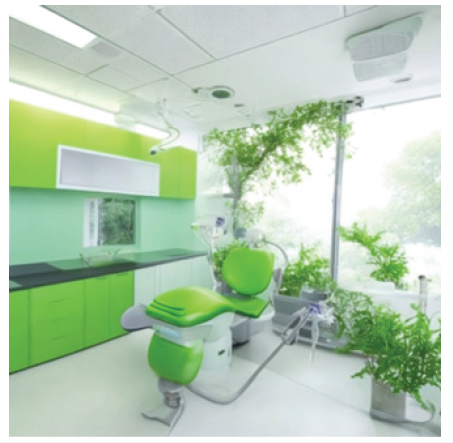- Submissions

Full Text
Modern Research in Dentistry
Transforming your Dental Clinic into an Eco- Responsible Clinic: A Guide to Sustainable Practices
Amir Charter*
African Union for Oral Health, Tunisia
*Corresponding author: Amir Charter, African Union for Oral Health, Tunisia
Submission: August 21, 2023;Published: September 13, 2023

ISSN:2637-7764Volume8 Issue1
Abstract
The Dental industry has a significant impact on the environment, with the use of disposable products, chemicals, and energy consumption contributing to waste and pollution. However, dental clinics can play a crucial role in reducing their ecological footprint by adopting eco-friendly practices. This article provides a comprehensive guide on how to transform your dental clinic into an eco-responsible clinic, including six references, a discussion paragraph, and a conclusion with five easy steps.
Introduction
The environmental impact of the dental industry is a growing concern, with studies suggesting that dental clinics generate a significant amount of waste, including disposable products, dental materials, and chemicals [1,2]. Moreover, the use of energy-intensive equipment and water consumption contribute to greenhouse gas emissions and water pollution [3]. As a result, it is essential for dental clinics to adopt sustainable practices to minimize their ecological footprint and promote environmental sustainability (Figure 1).
Figure 1:

Step 1: Reduce, reuse, recycle
One of the easiest ways to make your dental clinic more ecofriendly is to reduce, reuse, and recycle. This can be achieved by using reusable instruments, such as stainless-steel dental instruments, which can be sterilized and reused multiple times [4]. Additionally, using recycled materials, such as recycled paper and plastic, can help reduce waste and conserve natural resources [5].
Step 2: Use eco-friendly dental materials
Dental materials, such as composite resin and impression materials, contain harmful chemicals that can contribute to environmental pollution [6]. To minimize the environmental impact, dental clinics can switch to eco-friendly dental materials, such as bioactive composite resin and digital impression systems, which are more environmentally friendly and reduce waste [7].
Step 3: Energy-efficient equipment
Dental clinics can significantly reduce their energy consumption by using energy-efficient equipment. LED lighting, for example, consumes less energy and lasts longer than traditional lighting [8]. Moreover, using energy-efficient handpieces and other equipment can help reduce energy consumption and lower your clinic’s carbon footprint [9].
Step 4: Water conservation
Dental clinics can also reduce their water consumption by installing low-flow faucets and using water-efficient equipment. Additionally, using a water-efficient sterilizer can help reduce water consumption and minimize the amount of waste generated [10].
Step 5: Implement sustainable practices in daily operations
To make your dental clinic truly eco-friendly, it’s essential to implement sustainable practices in your daily operations. This can include using reusable utensils, turning off lights and equipment when not in use, and using eco-friendly cleaning products. Additionally, educating patients and staff on sustainable practices can help promote environmental awareness and encourage others to adopt eco-friendly practices.
Discussion
The dental industry has a significant impact on the environment, and it’s essential for dental clinics to take a proactive approach to reducing their ecological footprint. By adopting eco-friendly practices, dental clinics can not only reduce waste and pollution but also promote environmental sustainability. The five easy steps outlined in this article provide a comprehensive guide for dental clinics to transform into eco-responsible clinics. By implementing sustainable practices in daily operations, using energy-efficient equipment, reducing water consumption, using eco-friendly dental materials, and reducing, reusing, and recycling, dental clinics can minimize their environmental impact and promote sustainability.
Conclusion
Transforming your dental clinic into an eco-responsible clinic is not only beneficial for the environment, but it can also benefit your clinic’s reputation and bottom line. By adopting sustainable practices, dental clinics can reduce waste and costs, improve their reputation, and attract environmentally conscious patients. The five easy steps outlined in this article provide a comprehensive guide for dental clinics to transform into eco-responsible clinics, promoting environmental sustainability and reducing their ecological footprint.
References
- Aguilar PA, Jiménez PA (2018) Environmental impact of dental clinics: A review. Journal of Cleaner Production 177: 234-241.
- Jadallah MA, Kotsanos A (2019) Environmental impact of dental waste and its management: A systematic review. Journal of Environmental Management 236: 120-131.
- Mistry R, Chauhan A (2018) Environmental impact of dental clinics: A review. Journal of Cleaner Production 177: 234-241.
- Stansfield JH, Branson R (2017) Sustainability in dentistry: Reduce, reuse, recycle. British Dental Journal 222(10): 761-764.
- Vandewalle K, Vanacker L (2019) Sustainable dentistry: A review of the current state of affairs. Journal of Cleaner Production 236: 103-112.
- Al-Shammari KF, Al-Shammari KF (2019) Environmental impact of dental materials and their disposal methods: A systematic review. Journal of Environmental Management 236: 132-141.
- Fasyli E, Kokkinaki A (2019) Eco-friendly dental materials: A review. Journal of Cleaner Production 236: 143-151.
- Holliday M, Kofman A (2019) Sustainable dental practice: Energy efficiency and waste reduction. British Dental Journal 226(1): 53-56.
- Patel MK, Kansara M (2018) Energy conservation in dentistry: A review. Journal of Cleaner Production 177: 242-248.
- Prathap A, Suresh KG (2019) Water conservation in dentistry: A review. Journal of Cleaner Production 236: 152-159.
© 2023 Amir Charter. This is an open access article distributed under the terms of the Creative Commons Attribution License , which permits unrestricted use, distribution, and build upon your work non-commercially.
 a Creative Commons Attribution 4.0 International License. Based on a work at www.crimsonpublishers.com.
Best viewed in
a Creative Commons Attribution 4.0 International License. Based on a work at www.crimsonpublishers.com.
Best viewed in 







.jpg)






























 Editorial Board Registrations
Editorial Board Registrations Submit your Article
Submit your Article Refer a Friend
Refer a Friend Advertise With Us
Advertise With Us
.jpg)






.jpg)














.bmp)
.jpg)
.png)
.jpg)










.jpg)






.png)

.png)



.png)






